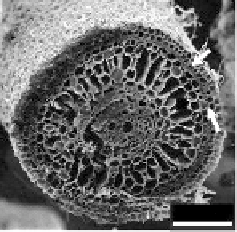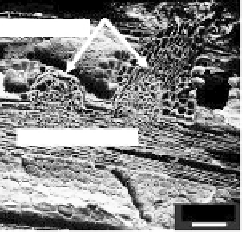Agriculture Reference
In-Depth Information
(a)
(b)
P
E
CC
P
CC
SC
0.1 mm
0.1 mm
RH
(c)
(d)
branch roots
aerenchyma
CC
AE
central cylinder
P
E
0.1 mm
0.1 mm
SC
(e)
crack
aerenchyma
0.1 mm
Figure 6.2
Cross-sections of primary rice roots. (a) Radial section close to tip showing
intercellular spaces (I), central cylinder (CC), and rhizodermis (RH). (b) and (c) Radial
sections of younger (39 days) and older (72 days) basal parts showing exodermis (E),
schlerenchymatous cylinder (SC), parenchymatous or cortical cells (P) and aerenchyma
(AE). (d) and (e) Axial sections of mature root (72 days) showing break through of lateral
roots (Butterbach-Bahl
et al
., 2000). Reproduced by permission of verlag
recycling and ATP synthesis (Setter
et al
., 1997). However these adaptations
would not serve a vigorously growing root system in normal circumstances.
Transport of gases through the aerenchyma may occur by diffusion and,
where pressure gradients develop, by convection. Pressurized flow is important
in wetland plants with root systems permitting a throughflow of gases, but
is insignificant
in other plants (Beckett
et al
., 1988; Skelton and Alloway,





